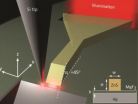Steady relationships reduce amphetamine's rewarding effects
Animal study suggests having a lifelong mate leads to greater resistance to drug
2011-06-01
(Press-News.org) Long-term relationships make the commonly abused drug amphetamine less appealing, according to a new animal study in the June 1 issue of The Journal of Neuroscience. The findings suggest that social bonds formed during adulthood lead to changes in the brain that may protect
against drug abuse.
Prairie voles are rodents that form lifelong bonds with mating partners. In the new study, researchers directed by Zuoxin Wang, PhD, of Florida State
University, found that male voles in established relationships displayed less interest in amphetamine compared with their single counterparts.
Amphetamine exposure led to changes in the nucleus accumbens — a part of the brain's reward system — that differed depending on the relationship status
of the voles.
Wang and his colleagues found brain cells of both paired and single voles released a similar amount of dopamine — a brain chemical important in
pleasurable activities like eating and sex — in response to amphetamine. However, this released dopamine may have had differential effects in paired
and single voles. Once released, dopamine binds to molecules called receptors on the surface of brain cells. Amphetamine use increased D1 receptor
binding in the nucleus accumbens in single voles, but decreased it in paired voles, suggesting the single and paired voles had opposite responses to
the drug.
Drugs that blocked dopamine from binding to the D1 receptor in the nucleus accumbens lessened amphetamine reward in single voles, while drugs that
increased dopamine binding at this site appeared to make amphetamine more appealing to the paired voles.
"Our results indicate that the pair bonding experience may alter the neurobiological response to drugs of abuse, which in turn may diminish the
rewarding effects of the drug itself," study author Wang said.
Earlier work in Wang's laboratory showed single voles sought out the rewarding effects of amphetamine and that repeated exposure to the drug threw off
their drive to form lifelong partnerships. In the current study, the researchers explored whether relationships formed during adulthood could buffer
against amphetamine's rewarding properties.
"While this study is very interesting, it will be important to determine whether pair-bonded voles would be less likely to work for drugs of abuse if given unlimited access," said Larry Young, PhD, an expert in social behavior at Emory University, who was unaffiliated with the study. "Understanding the neurobiology of how social bonds protect against the rewarding aspects of drug abuse may ultimately inform novel therapies for addiction."
INFORMATION:
The research was supported by the National Institute on Drug Abuse and the National Institute of Mental Health.
The Journal of Neuroscience is published by the Society for Neuroscience, an organization of more than 40,000 basic scientists and clinicians who study the brain and nervous system. Wang can be reached at zwang@psy.fsu.edu. More information on the science of addiction can be found in the Society's Brain Briefings and Research & Discoveries publications.
END
ELSE PRESS RELEASES FROM THIS DATE:
2011-06-01
STANFORD, Calif. — More than two dozen widely cited studies linking genes or other "biomarkers" to specific diseases vastly overstate the association, according to new research from an expert in scientific study design at the Stanford University School of Medicine. As a result, clinicians may be making decisions for their patients based on inaccurate conclusions not supported by other, larger studies.
The widely cited studies include one linking the BRCA1 mutation with colon cancer, another that links levels of C-reactive protein in the blood with cardiovascular disease ...
2011-06-01
The creation of a new quasiparticle called the "hybrid plasmon polariton" may throw open the doors to integrated photonic circuits and optical computing for the 21st century. Researchers with the U.S. Department of Energy (DOE)'s Lawrence Berkeley National Laboratory (Berkeley Lab) have demonstrated the first true nanoscale waveguides for next generation on-chip optical communication systems.
"We have directly demonstrated the nanoscale waveguiding of light at visible and near infrared frequencies in a metal-insulator-semiconductor device featuring low loss and broadband ...
2011-06-01
Two years ago, a widely publicized scientific report plucked an old mouse virus out of obscurity and held it up as a possible cause of Chronic Fatigue Syndrome. According to a new study published today by a group of researchers in California, Wisconsin and Illinois, that report was wrong.
The mouse virus is not the culprit in Chronic Fatigue Syndrome, said University of California, San Francisco Professor Jay A. Levy, MD, the senior author on the study, published this week by the journal Science.
"There is no evidence of this mouse virus in human blood," said Levy, ...
2011-06-01
A cell phone-sized, wireless near-infrared device is as reliable as the current "gold standard" invasive tests in determining bladder disease, according to a study by researchers at the University of British Columbia, Vancouver Coastal Health and the Child & Family Research Institute (CFRI).
The new physiologic information gathered through near-infrared spectroscopy (NIRS) could also advance treatment that tackles the root causes of urinary incontinence, says the research team.
Published in the current issue of the International Journal of Spectroscopy, the study is ...
2011-06-01
Although known for over a century, cryptosporidiosis was believed to be an extremely rare condition and it only gained attention with the discovery that it can affect humans, especially immune-compromised individuals. It is caused by a single-cell parasite, one of a family known as cryptosporidia. Some cryptosporidia also infect reptiles, where after a sometimes lengthy incubation period they cause gastrointestinal problems even in otherwise healthy individuals. The condition is usually persistent and is presently impossible to cure. It is therefore important to minimize ...
2011-06-01
A prior fracture at least doubles a patient's future fracture risk – yet numerous studies from across the world have found that healthcare systems fail to respond to the first fracture to prevent future fractures. Professor Cyrus Cooper, chair of the Committee of Scientific Advisors of the International Osteoporosis Foundation (IOF) and director of the MRC Lifecourse Epidemiology Unit, University of Southampton in the UK stated, "Studies from the UK, USA and Australia have reported that 45% or more of today's hip fracture patients have a prior fracture history. Healthcare ...
2011-06-01
Decorative white silk crosses are an ingenious tactic used by orb-weaving spiders to protect their webs from damage, a new study from the University of Melbourne has revealed.
The team, led by Dr Andre Walter and Professor Mark Elgar from the University of Melbourne's Department of Zoology, found that orb-weaving spiders respond to severe damage to their webs by building bigger silk crosses, but if the damage is mild they don't bother adding extra decoration.
Professor Mark Elgar said web damage is costly for spiders as a lot of nutritional resources are required to ...
2011-06-01
A large number of illnesses stem from misfolded proteins, molecules composed of amino acids. Researchers at the University of Zurich have now studied protein misfolding using a special spectroscopic technique. Misfolding, as they report in Nature, is more frequent if the sequence of the amino acids in the neighboring protein domains is very similar.
Proteins are the main molecular machines in our bodies. They perform a wide range of functions, from digesting and processing nutrients, converting energy and aiding cell structure to transmitting signals in cells and the ...
2011-06-01
The strength of sun cream recently recommended by the National Institute for Health and Clinical Excellence (NICE) to stave off sunburn is far too low and "not in the interests of public health," warns the Drug and Therapeutics Bulletin (DTB).
NICE should rethink its advice, and soon, it says.
NICE recommends sunscreens with a sun protection factor, or SPF, of 15 as sufficient to prevent sunburn and the subsequent potential risk of skin cancer.
But DTB says that this is based on standard test conditions in which manufacturers apply 2 mg/cm2 of product to the skin.
"In ...
2011-06-01
Permanent hair dye gives the most serious adverse effects, yet there are also many reactions to facial and body moisturisers. This comes from the first report from the National Register of Adverse Effects from Cosmetic Products published by the Norwegian Institute of Public Health.
"The Register gives us a better overview of the products that cause adverse effects, the type of adverse effect and who experiences them. Then we can make an assessment and even warn against the use of certain products," says researcher Berit Granum at the Division of Environmental Medicine ...
LAST 30 PRESS RELEASES:
[Press-News.org] Steady relationships reduce amphetamine's rewarding effects
Animal study suggests having a lifelong mate leads to greater resistance to drug



